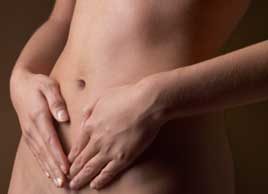What you should know about uterine fibroids
These benign tumours are common, but can cause abdominal pain, pressure, or other complications

Source: Best Health magazine, December 2012; Image: Thinkstock
Gillian Baker had been struggling with a variety of health problems for many years without knowing why. ‘I had crazy menstrual periods, bloating, cramping, irrational emotions; it was hell on my body,’ says the 38-year-old Grade 2 teacher in London, Ont. She had endured several trips to the emergency room after experiencing excessive bleeding. About four years ago, she was told she had uterine fibroids, but even with a clear diagnosis doctors could not get her symptoms under control.
Her menstrual bleeding was so heavy at times that she needed iron infusions and vitamin B12 shots. Baker often felt exhausted and had to take time off work. One fateful day in the summer of 2010, her bleeding became life-threatening: She ended up in the hospital where, over three days, she needed two blood transfusions. ‘They tried everything. My body started shutting down. I was hours away from a hysterectomy,’ says Baker, who is single and hoping to get pregnant soon using donor sperm. ‘My gynecologist said, ‘We’ve done everything we can.’ And even though I wanted children in the future, I agreed.’
That’s when Dr. George Vilos, a surgeon at St. Joseph’s Health Care in London, was called in to assess Baker’s situation. Vilos, a professor of obstetrics and gynecology at the Schulich School of Medicine and Dentistry at the University of Western Ontario, is passionate about reducing the number of hysterectomies to treat uterine fibroids and other conditions. Vilos told Baker: ‘I will not let you have a hysterectomy at 36.’
In August 2010, Baker had a one-hour procedure called a hysteroscopic myomectomy, a surgery that removes fibroids in pieces while leaving the uterus intact. Baker now has a chance to have a baby, she says. And her periods have become perfectly normal. ‘I am thrilled.’
What are uterine fibroids?
These benign tumours are very common, and most women who have them don’t even realize it. Uterine fibroids are made up of smooth muscle within the wall of the uterus. They typically show up in a woman’s 20s and 30s. ‘If you look hard enough, you can find some form of fibroids in up to 70 percent of women,’ says Dr. Guylaine Lefebvre, chief of obstetrics and gynecology at St. Michael’s Hospital in Toronto.
Most of the time they do not cause any problems, but about 30 percent of women who have fibroids are troubled by symptoms such as heavy menstrual bleeding, abdominal pain, pressure on the abdomen and bladder problems. In rare instances, they can lead to problems with fertility and pregnancy.
‘Fibroids are like real estate: The most important thing is location,’ says Lefebvre, who is a past-president of the Society of Obstetricians and Gynaecologists of Canada. They attach themselves to the uterine wall and can either grow outward toward the other organs, grow inward toward the inside of the uterus, or stay embedded inside the uterine walls. If they grow on the outside of the uterus, they usually don’t cause problems unless they start pressing on other organs and tissues. If they grow toward the inside of the uterus, it’s a different story. They can increase menstrual bleeding by distorting and enlarging the uterine cavity, and they can also cause infertility and miscarriages. Fibroids embedded in the uterine wall may cause no symptoms at all, or they can start infringing on the uterus as the inward-growing ones do.
Wherever they are on the uterus, fibroids can grow rapidly in both size and number. They typically range from the size of a pea up to the size of a grapefruit, but Lefebvre has removed fibroids the size of a newborn baby’six or seven pounds. On average, however, fibroids that require surgery to remove weigh about half a pound. Once, she removed 55 from one uterus.
You may be genetically preprogrammed to develop these tumours, Lefebvre says. ‘If your mother had fibroids, you are more likely to develop them, but lots of women get them whose mothers never had them.’ And they are more common in black and Caucasian women than in those of Asian descent. If you are obese, you are also more likely to develop fibroids.
Pregnancy can reduce the risk of fibroids, since a growing fetus draws the blood away from the fibroids. ‘Childbirth is a predator of fibroids. For every child a woman has, the incidence of developing fibroids drops by 20 percent,’ says Vilos.
In rare cases’about one in 10,000 women admitted to hospital with serious symptoms ‘a lump that acts like a fibroid turns out to be a uterine sarcoma, meaning a malignant tumour. These cancers cause bleeding and pain, and grow rapidly. After menopause, fibroids decrease in size and do not usually cause problems, so ‘if a uterine mass suddenly showed up in a post-menopausal woman, along with bleeding and pain, we’d worry,’ says Lefebvre.
Treatment options
Obesity is a risk factor for fibroids, but other than maintaining a healthy weight, there are no lifestyle measures’such as nutritional remedies’you can take to prevent or cure fibroids. Treatment depends on your symptoms, your age, whether and when you want to get pregnant, the size and location of your fibroids, and the treatments that are available in the area where you live. Here are the options to consider:
Mirena IUD
This birth-control method retards the growth of fibroids and may even shrink them, says Vilos. It may be effective in curbing menstrual bleeding and cramps. The IUD is removed after five years, at which point it is fine to get pregnant if fibroids aren’t causing problems with your fertility.
Myomectomy
This means surgically removing fibroids while leaving the uterus intact. If the fibroids are growing inside the uterine cavity, they are removed through the cervix (hysteroscopically). If they are growing toward the outside of the uterus, an incision is made on the abdomen and the fibroid is removed through it laparoscopically. If necessary, a machine called a morcellator cuts the fibroid up into pieces, which can then be removed through smaller incisions. The da Vinci surgical robot’a breakthrough myomectomy surgical technology that is now available in Toronto, London and Montreal’is even more precise and less invasive. The da Vinci uses a smaller incision, and allows for a faster recovery period for patients undergoing myomectomy procedures.
Embolization
This procedure involves cutting off the flow of blood to the fibroid, to shrink it by up to 50 percent, rather than removing it. A tube is inserted into the femoral artery in the groin, which leads to the uterus. Tiny plastic spheres are injected into the tube, and they make their way to the fibroid and block its blood supply. The downside: The spheres stay within the fibroid and the uterus forever. Vilos’s lab in London is testing a new material, Gelfoam, which is absorbed by the body. The Gelfoam procedure appears to be less painful.
Hysterectomy
Removing the uterus altogether is a permanent solution for women who have completed their family or who don’t want children. Hysterectomies have improved, says Vilos. ‘We now recommend minimally invasive hysterectomies using laparoscopic technology, and try to avoid making big incisions.’
This article was originally titled "Uterine fibroids" in the December 2012 issue of Best Health. Subscribe today to get the full Best Health experience’and never miss an issue!




